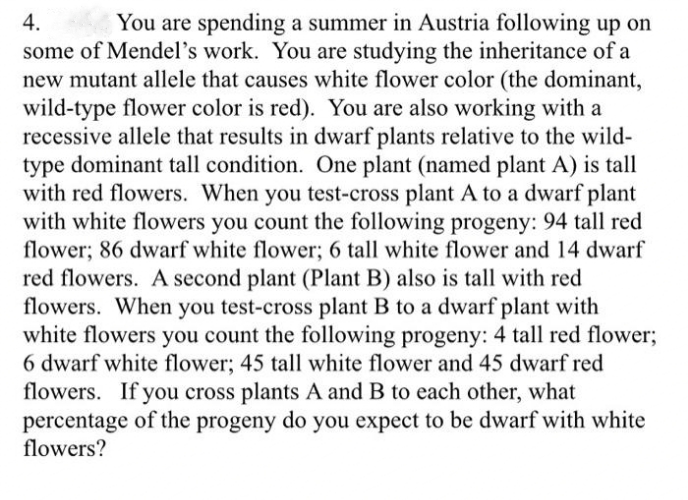You are spending a summer in Austria following up on some of Mendel's work. You are studying the inheritance of a new mutant allele that causes white flower color (the dominant, wild-type flower color is red). You are also working with a recessive allele that results in dwarf plants relative to the wild- type dominant tall condition. One plant (named plant A) is tall with red flowers. When you test-cross plant A to a dwarf plant 4.
You are spending a summer in Austria following up on some of Mendel's work. You are studying the inheritance of a new mutant allele that causes white flower color (the dominant, wild-type flower color is red). You are also working with a recessive allele that results in dwarf plants relative to the wild- type dominant tall condition. One plant (named plant A) is tall with red flowers. When you test-cross plant A to a dwarf plant 4.
Biology: The Unity and Diversity of Life (MindTap Course List)
14th Edition
ISBN:9781305073951
Author:Cecie Starr, Ralph Taggart, Christine Evers, Lisa Starr
Publisher:Cecie Starr, Ralph Taggart, Christine Evers, Lisa Starr
Chapter13: Observing Patterns In Inherited Traits
Section: Chapter Questions
Problem 7GP: Several alleles affect traits of roses, such as plant form and bud shape. Alleles of one gene govern...
Related questions
Question
100%

Transcribed Image Text:4.
You are spending a summer in Austria following up on
some of Mendel's work. You are studying the inheritance of a
new mutant allele that causes white flower color (the dominant,
wild-type flower color is red). You are also working with a
recessive allele that results in dwarf plants relative to the wild-
type dominant tall condition. One plant (named plant A) is tall
with red flowers. When you test-cross plant A to a dwarf plant
with white flowers you count the following progeny: 94 tall red
flower; 86 dwarf white flower; 6 tall white flower and 14 dwarf
red flowers. A second plant (Plant B) also is tall with red
flowers. When you test-cross plant B to a dwarf plant with
white flowers you count the following progeny: 4 tall red flower;
6 dwarf white flower; 45 tall white flower and 45 dwarf red
flowers. If you cross plants A and B to each other, what
percentage of the progeny do you expect to be dwarf with white
flowers?
Expert Solution
This question has been solved!
Explore an expertly crafted, step-by-step solution for a thorough understanding of key concepts.
Step by step
Solved in 2 steps

Knowledge Booster
Learn more about
Need a deep-dive on the concept behind this application? Look no further. Learn more about this topic, biology and related others by exploring similar questions and additional content below.Recommended textbooks for you

Biology: The Unity and Diversity of Life (MindTap…
Biology
ISBN:
9781305073951
Author:
Cecie Starr, Ralph Taggart, Christine Evers, Lisa Starr
Publisher:
Cengage Learning

Biology: The Dynamic Science (MindTap Course List)
Biology
ISBN:
9781305389892
Author:
Peter J. Russell, Paul E. Hertz, Beverly McMillan
Publisher:
Cengage Learning

Biology 2e
Biology
ISBN:
9781947172517
Author:
Matthew Douglas, Jung Choi, Mary Ann Clark
Publisher:
OpenStax

Biology: The Unity and Diversity of Life (MindTap…
Biology
ISBN:
9781305073951
Author:
Cecie Starr, Ralph Taggart, Christine Evers, Lisa Starr
Publisher:
Cengage Learning

Biology: The Dynamic Science (MindTap Course List)
Biology
ISBN:
9781305389892
Author:
Peter J. Russell, Paul E. Hertz, Beverly McMillan
Publisher:
Cengage Learning

Biology 2e
Biology
ISBN:
9781947172517
Author:
Matthew Douglas, Jung Choi, Mary Ann Clark
Publisher:
OpenStax

Biology: The Unity and Diversity of Life (MindTap…
Biology
ISBN:
9781337408332
Author:
Cecie Starr, Ralph Taggart, Christine Evers, Lisa Starr
Publisher:
Cengage Learning